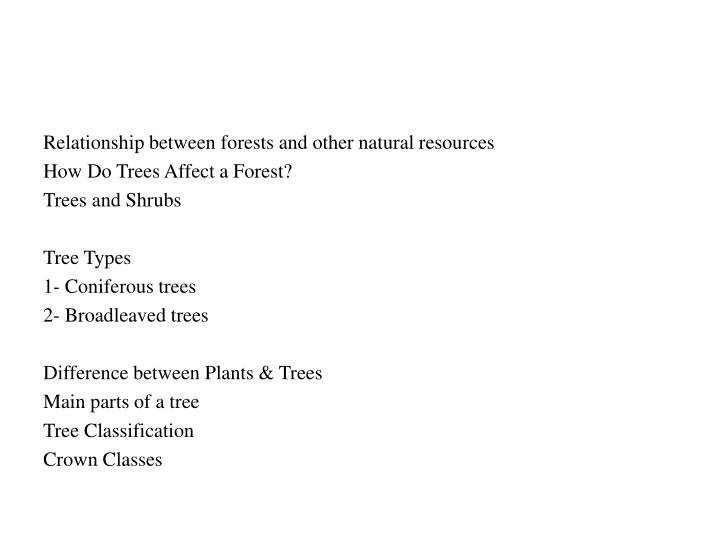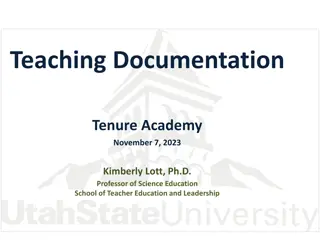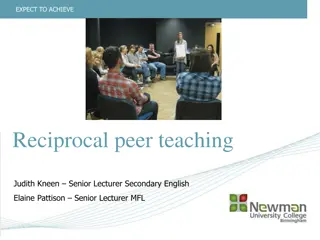
The Role of Trees and Forests in Ecosystems
Trees and forests play crucial roles in ecosystems by regulating water flow, filtering pollutants, providing habitats for various organisms, and influencing climate and soil quality. Explore the relationship between forests and natural resources, the importance of trees in the environment, and how different tree types affect forest ecosystems.
Download Presentation

Please find below an Image/Link to download the presentation.
The content on the website is provided AS IS for your information and personal use only. It may not be sold, licensed, or shared on other websites without obtaining consent from the author. If you encounter any issues during the download, it is possible that the publisher has removed the file from their server.
You are allowed to download the files provided on this website for personal or commercial use, subject to the condition that they are used lawfully. All files are the property of their respective owners.
The content on the website is provided AS IS for your information and personal use only. It may not be sold, licensed, or shared on other websites without obtaining consent from the author.
E N D
Presentation Transcript
Relationship between forests and other natural resources How Do Trees Affect a Forest? Trees and Shrubs Tree Types 1- Coniferous trees 2- Broadleaved trees Difference between Plants & Trees Main parts of a tree Tree Classification Crown Classes
Relationship between forests and other natural resources Forests play important roles in the water cycle, the forest filters the rain as it falls and serve as storage areas. A forest regulates water flow, making it possible for fish and other animal and plant life to survive. Forests filter rain and help reduce the erosion of soils. Trees and shrubs are responsible for removing much of the pollutant materials from the air and water run-off. 2/26/25 Trees and Shrubs 2
Forests and living organisms have many relationships, Algae, fungi, and other plants make their homes in the forest. Forests also protection and nesting sites for many species of birds and fish. Forests and wildlife relationships greatly vary depending on species; the wildlife in each forest region varies due to climate and harvesting times. 2/26/25 Trees and Shrubs 3
Importance of Trees & Forests (Air) (Soil) (Soil) Produce O2 Absorb CO2 Enrich the soil with decaying leaves etc. Controls erosion Importance of Trees & Forests (Wildlife) (People) Homes Shade & wind protection & shelter (Things we get from trees) Food (nuts, fruit) (People) Oils recreation Wood sap
How Do Trees Affect a Forest? 1. They break the wind and with less air movement, there is less drying. 2. They shade the ground from the sun thereby lowering air temperature; forests tend to be cool, humid places and the soil is moist there. 3. Forest soil is also very rich in nutrient because of all the leaves, branches, and stems which decompose into humus. 2/26/25 Trees and Shrubs 6
What makes up forest? http://images.google.com/images?q=tbn:d-Hn347OnagC:www.glasgow.gov.uk/html/about/crest/tree.jpg In terms of woody plants, the two main types are trees and shrubs. What differences in a tree and a shrub? are the main http://images.google.com/images?q=tbn:MbwXD72ap3gC:www.thebfs.org.uk/rules/shrub.gif 2/26/25 Trees and Shrubs 7
Trees and Shrubs A Tree is a woody plant, typically large with a well-defined stem and a more or less defined crown. A Shrub is a woody plant, usually having several persistent woody stems branching from the ground. 2/26/25 Trees and Shrubs 8
What is a tree? A tree is defined according to the following criteria: It must have a self supporting trunk. The trunk must be made of woody material. A tree usually grows to a height of 5 to 7 metres. 2/26/25 Trees and Shrubs 9
Tree Types: There are many thousands of different kinds of trees but all true trees are separated into two (2) basic classifications: 1- Coniferous trees which are also known as evergreens or softwoods 2- Broadleaved trees which are also known as deciduous or hardwoods . 2/26/25 Trees and Shrubs 10
Coniferous Trees Includes the pines, firs and other evergreens that usually have narrow needles instead of broadleaves. The term evergreen comes from the fact that the needles appear not to turn brown and fall to the ground at the approach of winter. The evergreens do shed their needles however, they do it so slowly that there are always green needles on the trees. 2/26/25 Trees and Shrubs 11
Broadleaved Trees This group of trees includes the oak, maple, poplar, birch and many others. These trees have broad, flat leaves instead of needles. Broadleaved trees produce flowers and after pollination these flowers develop seeds. 2/26/25 Trees and Shrubs 12
Difference between Plants & Trees All other plants differ from trees in at least one of these ways. 1- No plant with a soft, juicy stem is a tree. 2- Most plants are much shorter than trees. 3- Shrubs, like trees, have woody stems; but most shrubs have more than one stem, none of the stems grow so thick as to be called a trunk. 4- Some jungle vines grow several hundred metres long and have a woody stem. However, the stems of vines cannot support themselves. 2/26/25 Trees and Shrubs 13
Four main parts of a tree 1. Crown: where the tree increases each year in height and spread of branches by adding on a new growth of twigs. 2. Leaves: make up the crown and produce food for the tree (photosynthesis). 3. Trunk: supports the crown and produces the majority of the tree s useful wood. 4. Roots: anchors the tree, absorbs and stores water and nutrients. 2/26/25 Trees and Shrubs 14
Tree Classification Trees can be classified according to the position they occupy in the forest canopy or understory. Such as system measures how well a tree has grown relative to its closet competitors. (Trees that get the most sunlight generally grow fastest). 2/26/25 Trees and Shrubs 17
Crown Classes There are five crown classes: 1. Dominant: Have tops that rise above the general canopy level. They receive full sunlight from above and all sides. 2. Co-dominant: These trees make up the canopy level. Their crowns get full sunlight from above, but dominant and other co-dominate trees restrict some side sunlight. 2/26/25 Trees and Shrubs 18
3. Intermediate: These trees also occupy the average canopy level, but receive sunlight only from above. 4. Suppressed: These are trees that receive no direct overhead or side sunlight. They are usually are slow growing and are weak. 5. Dead trees (snags): These can be found in the canopy, understory or forest floor. 2/26/25 Trees and Shrubs 19






















